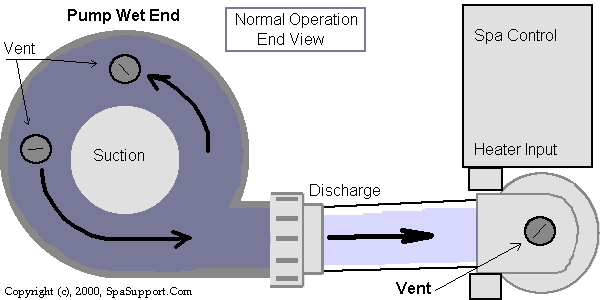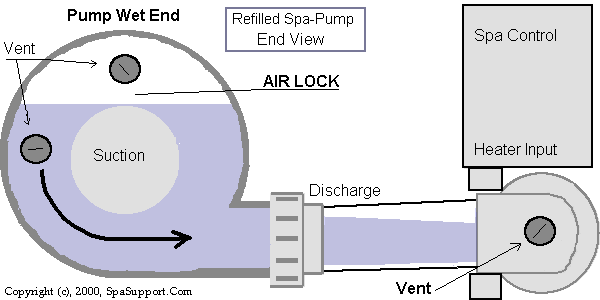| About Air Locks | Previous | |
|
Ever since plumbing was invented, air-locks have always been a problem. It's the reason why vents exist in the drain plumbing in your home, and why small vent valves are sometimes provided in strategic locations in your spa plumbing, and your filter. In this first section, we'll take a look at one of the most common spa air lock problems, it's one that plagues about 40% of all spas in use today.
Why does it exist? Because the pump wet end is rotated so that
the discharge goes out sideways, instead of straight up. If it went up, in virtually all
cases, the air lock would never exist because the air, will go up and out of the pump on its
own. Also, even if it still existed downline, the pump would be able to develop enough
pressure to force all of the air out. |
||
 |
||
| In this 'typical' side discharge installation, the pump is full of water and successfully maintaining pressure to the heater. (Note this installation is very common on older Cal-Spa systems). | ||
|
|
||
| Now, once the spa is drained, and then refilled, there will be a pocket of air trapped inside the top of the wet end. This is where all of the problems come from. With the air pocket, the rotating pump impeller cannot develop enough constant hydraulic pressure to force the air all the way through the system. | ||
 |
||
|
Typical end results of the air lock problem. Air will be constantly 're-gurgitated' by the impeller, keeping the water flow at an erratic state. |
||
 |
||
| What I do in this case is to run the pump on LOW speed, and slightly open one or more of the small air vents until a small amount of water flow is noticed, and is constant. What will also help this, is to close the heater discharge valve, on the other side of the heater, forcing ALL of the air out. I don't do this for very long, because leaks can develop under this kind of pressure. | ||